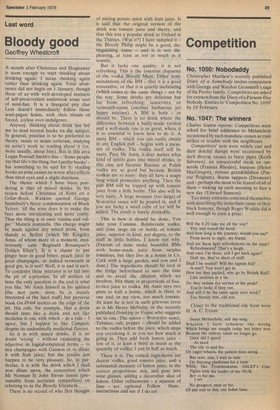Bloody good
Geoffrey Wheatcroft
A month after Christmas and Hogmanay is soon enough to start thinking about drinking again: I mean thinking again rather than drinking again. Total abstinence did not begin on 1 January, though those of us with well-developed instincts of self-preservation undertook some sort of mini-fast. It is a liturgical pity that Lent doesn't immediately follow those semi-pagan feasts, with their rituals of forced, joyless over-indulgence.
Anyway, thinking about drink has led me to read several books on the subject, In general, practice is to be preferred to theory, music to music criticism, studying an artist's work to reading about it (or, more usually, about him). But in this area Logan Pearsall Smith's line — 'Some people say that life's the thing, but I prefer books' — has something to be said for it: reading books on wine causes no worse after-effects than tired eyes and a slight dizziness.
The theme which I have been pondering is that of mixed drinks. In his review before Christmas of Notes on a Cellar-Book, Watkins quoted George Saintsbury's fierce condemnation of Black Velvet: 'all the wine does is to make the beer more intoxicating and more costly. Thus the thing is at once vicious and vulgar.' Mutatis mutandis, this charge might be made against any mixed drink, from shandy to Bellini (which Mr Kingsley Amis, of whom more in a moment, mysteriously calls 'Reginald Bosanquet's Golden Elixir'). It is a shame to put ginger beer in good bitter, peach juice in good champagne, or indeed vermouth in good gin, is it not? Well, it is and it isn't. To condemn these mixtures is to fall into the pit of a-priorism. In all matters of taste the only question in the end is what you like. Mr Amis himself in his spirited (the mot juste, since he is mainly interested in the hard stuff) but perverse book On Drink teeters on the edge of the pit. His rule, for example, that a drink should taste like a drink and not like medicine is one with which — as a rule — I agree, but I happen to like Campari, despite its undoubtedly medicinal flavour.
So it is with mixed drinks. It is no doubt 'wrong' — without examining the adjective in logical-empirical terms — to mix champagne with Guiness or to dilute it with fruit juice; but the results just happen to be very pleasant. So, in particular, it is with the drink which I shall now dilate upon, the concoction which Mr Norman St John Stevas insists (presumably from sectarian sympathies) on referring to as the Bloody Elizabeth.
There is no record of who first thought of mixing potato spirit with fruit juice. It is said that the original version of the drink was tomato juice and sherry, and that this was a popular drink at Oxford in the Thirties. (Was it?) I have sampled it — the Bloody Philip might be a good, distinguishing name — and it •is not displeasing, at least as not as much as it sounds.
But it lacks one quality: it is not refreshing. This is the essential character of the vodka Bloody Mary. Other commendations of the BM — that it is a good restorative, or that it is quietly inebriating (which comes to the same thing) — are by the way. Some drinks are delicious but far from refreshing: sauternes, or vermouth-cassis (another barbarous yet happy mixture). A BM is both — or should be. There is no drink where the difference between a badly-made version and a well-made one is so great, where it is so essential to know how to do it. A nasty BM — which you can easily obtain in any English pub — begins with a measure of vodka. The vodka itself will be nasty. Pace Mr Amis, it does matter what kind of spirits goes into mixed drinks, in this case not because Russian or Polish vodka are so good but because British vodkas are so nasty: they all have a soapy tang which permeates anything. Then the pub BM will be topped up with tomato juice from a little bottle. This also will be very nasty. A large measure (too large) of Worcester sauce will be poured in, and if you are lucky a small cube of ice will be added. The result is barely drinkable.
This is how it should be done. You take your Commie, Bolshevistic vodka, and your large tin or bottle of tomato juice, superior in kind, not degree, to the stuff in little bottles, I know not why. (Friends of mine make beautiful BMs with home-made juice from surplus tomatoes, but they live in a house in Co. Cork with a large garden, and you and I dont.) The ingredients should be iced in the fridge beforehand to save the time and to avoid the dilution which ice involves. Mix them in proportions of fiveto-two juice to vodka. Mr Amis says two pints to half a bottle, which is three to one and, in my view, too much tomato. At least he is not in such grievous error as is Mr Henry McNulty, in the recently published Drinking in Vogue, who suggests six to one. The spices — Worcester sauce, Tabasco, salt, pepper — should be added to the vodka before the juice, which stops you overdoing it, as you see how much is going in. Then add fresh lemon juice — lots of it, at least a third as much as the quantity of vodka; I put in half as much.
There it is. The critical ingredients are decent vodka, good tomato juice, and a substantial measure of lemon juice, in the correct proportions: mix, and pour into wine glasses, adding a decorative slice of lemon. Other refinements — a squeeze of lime — are optional. Follow these instructions and see if I do err. ,


































 Previous page
Previous page